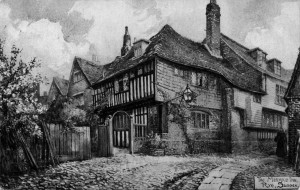What Famous Drawing Is In Little Mermaid Tavern
 Alfred Noyes wrote a skillful deal, and in many genres. A poet, novelist, sci-fictioneer, essayist and pamphleteer, he was especially famous for his narrative poems – first of all the highly melodramatic The Highwayman.
Alfred Noyes wrote a skillful deal, and in many genres. A poet, novelist, sci-fictioneer, essayist and pamphleteer, he was especially famous for his narrative poems – first of all the highly melodramatic The Highwayman.
Whether these poems accept aged all that well is… er, open up to contend – but I must confess a partiality for Noyes'south Tales of the Mermaid Tavern. Published in 1913, it'due south a mostly blank verse affair, whose narrator stumbles into everybody'due south dream…
Oh, right – into my dream: while taking a stroll nearly London and musing on history and verse, the fellow falls through time, and finds himself a tapster at the Mermaid Tavern, in the 1590s, where he waits on customers like Shakespeare, Marlowe, Jonson, Nashe, Raleigh…
Betwixt a tankard of ale and an eel-pie, our hero gets to listen while the best of Elizabethan theatre argue and tell tales, trade songs and improvise. Sir Wat Raleigh spins bounding main yarns, Marlowe and Jonson playfully brand a poaching Shakespeare into a sort of Robin Hood, they all read Greene's truthful concluding words (much less nasty than the Groatsworth of Wit), Puritan Richard Bame eavesdrops on reckless Marlowe – of whose demise, in the end, the company hears from a sobbing Tom Nashe… 
And it is clear as day who Noyes'south hero is: a Promethean Kit Marlowe, all genius, burn down and poetry – and stunningly handsome to boot. Poor Will Shakespeare never stands a chance – and soon loses centre-stage-
Oh – and this is all pre-Hotson: what happens in Deptford is a crime of passion over a doxy, and instead of Baines-the-Spy we get Bame-the-Puritan. Some day I'll have to dig deeper into this combination of misspelled name and religious persuasion… Ziegler, Preston-Peabody, Noyes… how did they come across this version of the beau?
That said, Tales of the Mermaid Tavern is one of those things that, like opera librettos and William Shakespeare Burton'south paintings – very much belong to a certain time, an a certain way of romanticising history. Still, bearing that in mind, it makes for picturesque reading. I remember it has a saving grace in the bitterish camber to the idealised Elizabethan era. The colours may exist those of a toy-theatre – and yet, "We like to imagine it like this," Noyes seems to whisper, "But let'due south not forget that like this was dangerous and full of shadows."
Should you be curious TotMT can be found on Internet Archive.
Source: https://claragiuliani.com/2016/05/26/tales-of-the-mermaid-inn/
Posted by: gomezclot1989.blogspot.com


0 Response to "What Famous Drawing Is In Little Mermaid Tavern"
Post a Comment